

What is Cloud 2 and the Facebook Imperative for Salesforce? What is Cloud 2?

Marc Benioff publicly launched Cloud 2 in April of 2010 with much fanfare. But what the heck is it? The thrust of Benioff’s presentation was that in this age of Facebook, Linkedin and Twitter – the traditional enterprise data model is disconnected from the conversation with the customer. “Why isn’t all Enterprise software like Facebook?” – Marc Benioff Salesforce.com’s Cloud 2 allows your organization to bridge the divide and tap into the dialogues occurring in these new social channels. Let’s take a step back to illustrate the point. Face it – people don’t want to pick up the phone to engage you. If you’re lucky, they went to your website to download the owners’ manual or checked out your FAQs (you do have that available for your customers – right?).
As of July 2009, there are more social users than email users. Neal Leavitt. Please note: This is a beta version of the new dblp website.You can find the classic dblp view of this page here.
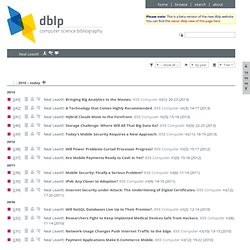
Neal Leavitt data released under the ODC-BY 1.0 license. 03-CO_0809-CloudComputingReadyForPrimetime. Berkeley Lab Study Finds Moving Select Computer Services to the Cloud Promises Significant Energy Savings. News Release BERKELEY, Calif.
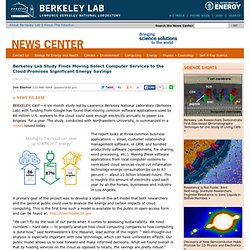
—A six-month study led by Lawrence Berkeley National Laboratory (Berkeley Lab) with funding from Google has found that moving common software applications used by 86 million U.S. workers to the cloud could save enough electricity annually to power Los Angeles for a year. The study, conducted with Northwestern University, is summarized in a report issued today. The report looks at three common business applications — email, customer relationship management software, or CRM, and bundled productivity software (spreadsheets, file sharing, word processing, etc.). Shmoocon 2010: Flying Instruments-Only: Legal and Privacy Issues in Cloud Computing 1/5. Shmoocon 2010: Flying Instruments-Only: Legal and Privacy Issues in Cloud Computing 2/5. Shmoocon 2010: Flying Instruments-Only: Legal and Privacy Issues in Cloud Computing 3/5.
Shmoocon 2010: Flying Instruments-Only: Legal and Privacy Issues in Cloud Computing 4/5. Shmoocon 2010: Flying Instruments-Only: Legal and Privacy Issues in Cloud Computing 5/5. SugataMitra_2013. Cloud Jargon Unwound: Distinguishing SaaS, IaaS and PaaS [Infographic] Why the U.S. Government is Moving to Cloud Computing. Image: opensourceway/Flickr It’s no secret that cloud computing is transforming businesses across industries and creating a paradigm shift by delivering hosted services through the internet with unabated cost benefits and business innovation.
But while the private sector is building on cloud computing’s myriad benefits, government organizations have also aggressively begun to capitalize on them. As an IBM solution architect and a trusted advisor to many of our government sector customers, I’ve seen how the financial constraints of the past five years have deeply affected how agencies deploy their solutions. These agencies are pressed to seek optimized business models while measuring their performance and service deliveries more closely — hence their inclination towards shared services. The federal government isn’t solely relying on the same cloud computing model that hosts some of your favorite consumer applications delivered via the cloud like Netflix or Instagram. Can Corporate Counsel Tame Cloud Computing? - Hot Topic - #thisisreallaw. Brought to you by the Real Law Editorial Team Owning data can be like owning a tiger.
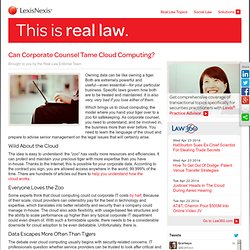
Both are extremely powerful and useful—even essential—for your particular business. Specific laws govern how both are to be treated and maintained. It is also very, very bad if you lose either of them. Podcasts : Seattle Cloud Security Regional Chapter. Where is the cloud? Geography, economics, environment, and jurisdiction in cloud computing. Where is the cloud?

Geography, economics, environment, and jurisdiction in cloud computing Paul T. Jaeger, Jimmy Lin, Justin M. Grimes, Shannon N. Simmons Abstract Cloud computing – the creation of large data centers that can be dynamically provisioned, configured, and reconfigured to deliver services in a scalable manner – places enormous capacity and power in the hands of users. Future Generation Computer Systems - Addressing cloud computing security issues. Abstract The recent emergence of cloud computing has drastically altered everyone’s perception of infrastructure architectures, software delivery and development models.
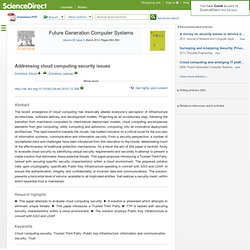
Projecting as an evolutionary step, following the transition from mainframe computers to client/server deployment models, cloud computing encompasses elements from grid computing, utility computing and autonomic computing, into an innovative deployment architecture. This rapid transition towards the clouds, has fuelled concerns on a critical issue for the success of information systems, communication and information security. From a security perspective, a number of unchartered risks and challenges have been introduced from this relocation to the clouds, deteriorating much of the effectiveness of traditional protection mechanisms. Research highlights Keywords. Legal Affairs: The Legal Implications of Cloud Computing. Cloud computing is one of the most recent in the long line of technological developments promised to bring convenience and efficiency to our busy professional and personal lives.
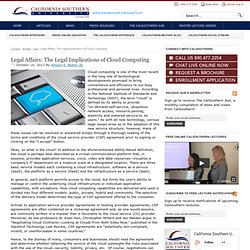
According to the National Institute of Standards and Technology (NIST), the term “cloud” is defined by its ability to provide “on-demand self-service, ubiquitous network access, resource pooling, elasticity and metered service to its users.” As with all new technology, various legal issues arise as to the adoption of this new service structure; however, many of these issues can be resolved or answered simply through a thorough reading of the terms and conditions of the cloud service provider (CSP) agreement prior to signing or clicking on the “I accept” button. Okay, so what is the cloud? In general, each platform permits access to the cloud, but limits the user’s ability to manage or control the underlying cloud infrastructure or individual application capabilities, with exceptions.
Allison E. InShare4.